Demography and Genealogical Analysis of Massese Sheep, a Native Breed of Tuscany
Abstract
Simple Summary
Abstract
1. Introduction
2. Materials and Methods
2.1. Data Collection
2.2. Statistical Analysis
- -
- The pedigree completeness. This provides information on the completeness of the pedigree in each generation as well as the number of missing parental records. The percentage completeness of the pedigree was computed. This was also assessed by calculating the mean maximum number of generations, the mean complete number, and the number of equivalent completed generations [29]. ENDOG includes information on the completeness of each ancestor in the pedigree to the 5th parental generation. The number of discrete generation equivalents was determined because it is considered another way to describe pedigree information [31].
- -
- The number of inbred animals, the average inbreeding coefficient (FPED), and the average numerator relationship coefficient (ANR) in the WP and RP and per province. The data were filtered, and animals with missing information were excluded from the calculation of population statistics, specifically the average inbreeding (FPED) and the average numerator relationship coefficient (ANR). The software CFC [30] computes the ANR using the indirect method proposed by Colleau (2002) [32], and FPED using Colleau’s modified algorithm [33]. FPED is the probability that at any randomly drawn locus, a given individual has two identical alleles by descent [34], which was calculated by the tabular method described by Meuwissen and Luo (1992) [35]. The FPED coefficient, number of inbred animals, and average inbreeding coefficient for each traced generation was calculated using ENDOG software. The distribution of the inbreeding level in the whole population was analyzed, and nine different class levels of inbreeding were considered: 0 < F ≤ 0.05; 0.05 < F ≤ 0.10; 0.10 < F ≤ 0.15; 0.15 < F ≤ 0.20; 0.20 < F ≤ 0.25; 0.25 < F ≤ 0.30; 0.30 < F ≤ 0.35; and 0.35 < F ≤ 0.40 [30].
- -
- The rate of inbreeding (ΔF) was considered to follow the variation in inbreeding over time, and was expressed per unit of time (generations, years) [32]. In the current study, the rate of inbreeding was calculated per generation using the classical formula ΔF = (Ft − Ft−1)/(1 − Ft−1), where Ft and Ft−1 are the average inbreeding in the (th) generation. Individuals that were present in more than one generation were included in all those generations in which they were present.
- -
- The effective population size (Ne) was calculated using ΔF as Ne = 1/(2ΔF). Small populations with shallow pedigrees, irrespectively of how Ne is computed, do not fit real populations well, thus leading to an overestimation of the real size of the population. To better characterize this, ENDOG gives three additional values of Ne by computing the regression coefficient (b) of the individual FPED over (i) the number of full generations traced; (ii) the maximum number of generations traced; and (iii) the number of equivalent complete generations, and considering the corresponding regression coefficient as the increase in FPED between two generations, and consequently, Ne = 1/(2b). The number of ancestors and the effective number of ancestors (fa) were also computed [32].
3. Results and Discussion
3.1. Demographic Data
3.2. Genealogical Data
3.3. Inbreeding Coefficient
4. Conclusions
Supplementary Materials
Author Contributions
Funding
Institutional Review Board Statement
Informed Consent Statement
Data Availability Statement
Conflicts of Interest
References
- Wanjala, G.; Bagi, Z.; Jávor, A.; Kusza, S. Impacts of climate change on sheep genetic diversity: A review. Nat. Res. Sustain. Dev. 2020, 10, 240–261. [Google Scholar] [CrossRef]
- Ferreira, J.; McManus, C.M.; Silveira, R.M.F.; da Silva, W.S.T.; Guilhermino, M.M.; Asensio, L.A.B.; Bozzi, R.; Façanha, D.A.E. Reference patterns for thermoregulation in Italian Massese ewes. J. Therm. Biol. 2023, 113, 10348. [Google Scholar] [CrossRef]
- FAO. The State of the World’s Biodiversity for Food and Agriculture. In FAO Commission on Genetic Resources for Food and Agriculture Assessments; Bélanger, J., Pilling, D., Eds.; FAO: Rome, Italy, 2019; Available online: http://www.fao.org/3/CA3129EN/CA3129EN.pdf (accessed on 17 September 2023).
- Tisdell, C. Socioeconomic causes of loss of animal genetic diversity: Analysis and assessment. Ecol. Econ. 2003, 45, 365–376. [Google Scholar] [CrossRef]
- Ciani, E.; Ciampolini, R.; D’Andrea, M.; Castellana, E.; Cecchi, F.; Incoronato, C.; D’Angelo, F.; Albenzio, M.; Pilla, F.; Matassino, D.; et al. Analysis of genetic variability within and among Italian sheep breeds reveals population stratification and suggests the presence of a phylogeographic gradient. Small Rum. Res. 2013, 112, 21–27. [Google Scholar] [CrossRef]
- Claps, S.; Annicchiarico, G.; Di Napoli, M.A.; Paladino, F.; Giorgio, D.; Sepe, L.; Rossi, R.; Di Trana, A. Native and non-native sheep breed differences in Canestrato Pugliese cheese quality: A resource for a sustainable pastoral system. Czech J. Food Sci. 2016, 34, 332–340. [Google Scholar] [CrossRef]
- Regione Toscana. Sviluppo Rurale Toscana 2023–2027. Available online: www.regione.toscana.it/-/bando-attuativo-dell-intervento-sra-aca14-allevatori-custodi-della-biodiversit%C3%A0-allevamento-di-razze-animali-autoctone-nazionali-a-rischio-di-estinzione/erosione-genetica-bando-annualit%C3%A0-2023 (accessed on 30 January 2024).
- Sistema Informatico Veterinario. Available online: https://www.vetinfo.it/j6_statistiche/index.html#/ (accessed on 15 November 2023).
- Fontanesi, L.; Beretti, F.; Riggio, V.; Dall’Olio, S.; Calascibetta, D.; Russo, V.; Portolano, B. Sequence characterization of the melanocortin 1 receptor (MC1R) gene in sheep with different coat colour and identification of the putative e allele at the ovine Extension locus. Small Rumin. Res. 2010, 91, 200–207. [Google Scholar] [CrossRef]
- Fontanesi, L.; Beretti, F.; Dall’Olio, S.; Portolano, B.; Matassino, D.; Russo, V. A melanocortin 1 receptor (MC1R) gene polymorphism is useful for authentication of Massese sheep dairy products. J. Dairy. Res. 2011, 78, 122–128. [Google Scholar] [CrossRef] [PubMed]
- Fontanesi, L.; Dall’Olio, S.; Beretti, F.; Portolano, B.; Russo, V. Coat colours in the Massese sheep breed are associated with mutations in the agouti signalling protein (ASIP) and melanocortin 1 receptor (MC1R) genes. Animal 2011, 5, 8–17. [Google Scholar] [CrossRef]
- Giantsis, I.A.; Antonopoulou, D.; Dekolis, N.; Zaralis, K.; Avdi, M. Origin, demographics, inbreeding, phylogenetics, and phenogenetics of Karamaniko breed, a major common ancestor of the autochthonous Greek sheep. Trop. Anim. Health Prod. 2022, 54, 73. [Google Scholar] [CrossRef]
- Russo, C.; Cecchi, F.; Accorsi, P.A.; Scampuddu, N.; Benvenuti, M.N.; Giuliotti, L. Investigation on sheep farm characteristics, wolf predation and animal welfare in the Grosseto province (Italy). Atti Soc. Tosc Sci. Nat. Mem. Ser. B 2020, 127, 113–120. [Google Scholar] [CrossRef]
- Bigi, D.; Zanon, A. Atlas of Native Breeds. Cattle, Horses, Sheep and Goats, Pigs Reared in Italy; Edagricole-New Business Media: Bologna, Italy, 2010. [Google Scholar]
- Todaro, M.; Dattena, M.; Acciaioli, A.; Bonanno, A.; Bruni, G.; Caroprese, M.; Mele, M.; Sevi, A.; Trabalza Marinucci, M. Aseasonal sheep and goat milk production in the Mediterranean area: Physiological and technical insights. Small Rum. Res. 2015, 126, 59–66. [Google Scholar] [CrossRef]
- Pugliese, C.; Acciaioli, A.; Rapaccini, S.; Parisi, G.; Franci, F. Evolution of chemical composition, somatic cell count and renneting properties of the milk of Massese ewes. Small Rum. Res. 1999, 35, 71–80. [Google Scholar] [CrossRef]
- Acciaioli, A.; Giustini, L.; Pianaccioli, L.; Malvezzi, G. Survey of feeding techniques in the sheep farms of Pistoia Apennines and milk quality. Sci. E Tec. Latt.-Casearia 2011, 62, 407–412. [Google Scholar]
- Parrini, S.; Sirtori, F.; Acciaioli, A.; Becciolini, V.; Crovetti, A.; Bonelli, A.; Franci, O.; Bozzi, R. Effect of farming system on meat traits of native Massese suckling lamb. Ital. J. Anim. Sci. 2021, 20, 71–83. [Google Scholar] [CrossRef]
- Serra, A.; Mele, M.; La Comba, F.; Conte, G.; Buccioni, A.; Secchiari, P. Conjugated Linoleic Acid (CLA) content of meat from three muscles of Massese suckling lambs slaughtered at different weights. Meat Sci. 2009, 81, 396–404. [Google Scholar] [CrossRef] [PubMed][Green Version]
- Figueredo, J.S.; Cruz, J.F.; Sousa, L.S.; Teixeira Neto, M.R.; Carneiro, P.L.S.; Brito, N.D.; Pinheiro, R.G.S.; Lacerda, K.S.O.; Mottin, V.D. Genetic diversity and population structure estimation of Brazilian Somali sheep from pedigree data. Small Rumin. Res. 2019, 179, 64–69. [Google Scholar] [CrossRef]
- Hashemi, M.; Hossein-Zadeh, N.G. Population genetic structure analysis of Shall sheep using pedigree information and effect of inbreeding on growth traits. Ital. J. Anim. Sci. 2020, 19, 1195–1203. [Google Scholar] [CrossRef]
- Bramante, G.; Pieragostini, E.; Ciani, E. Genetic Variability within the Murgese Horse Breed Inferred from Genealogical Data and Morphometric Measurements. Diversity 2022, 14, 422. [Google Scholar] [CrossRef]
- Cecchi, F.; Paci, G.; Spaterna, A.; Ragatzu, M.; Ciampolini, R. Demographic approach on the study of genetic parameters in the dog Braque Français type Pyrénées Italian population. Ital. J. Anim. Sci. 2016, 15, 30–36. [Google Scholar] [CrossRef]
- Ciampolini, R.; Cecchi, F.; Paci, G.; Policardo, C.; Spaterna, A. Investigation on the Genetic Variability of the American Pit Bull Terrier dogs belonging to an Italian breeder using Microsatellite Markers and genealogical data. Cytol. Genet. 2013, 47, 217–221. [Google Scholar] [CrossRef][Green Version]
- Michels, P.W.; Distl, O. Genetic Diversity and Trends of Ancestral and New Inbreeding in Deutsch Drahthaar Assessed by Pedigree Data. Animals 2022, 12, 929. [Google Scholar] [CrossRef]
- Giuliotti, L.; Benvenuti, M.N.; Ventura, E.; Fresi, P.; Preziuso, G.; Cecchi, F. Massese sheep characteristics and demo-genetic trends in the province of Pisa (Italy). Rend. Lincei Sci. Fis. Nat. 2023, 34, 1221–1229. [Google Scholar] [CrossRef]
- SAS; JMP. User’s Guide, Version 5.0; SAS Inst.: Cary, NC, USA, 2002. [Google Scholar]
- Kinghorn, B.P.; Kinghorn, S. Pedigree Viewer-a graphical utility for browsing pedigreed data sets. In Proceedings of the 5th World Congress on Genetics Applied to Livestock Production University of Guelph, Guelph, ON, Canada, 7–12 August 1994; Volume 22, pp. 85–86. [Google Scholar]
- Gutiérrez, J.P.; Goyache, F. A note on ENDOG: A computer program for analysing pedigree information. J. Anim. Breed. Genet. 2005, 122, 172–176. [Google Scholar] [CrossRef] [PubMed]
- Sargolzaei, M.; Iwaisaki, H.; Colleau, J.J. CFC (Contribution, Inbreeding (F), Coancestry), Release 1.0. A software package for pedigree analysis and monitoring genetic diversity. In Proceedings of the 8th World Congress on Genetics Applied on Livestock Production, Belo Horizonte, Brazil, 13–18 August 2006. Instituto Prociência Eds. [Google Scholar]
- Siderits, M.; Baumung, R.; Fuerst-Waltl, B. Pedigree analysis in the German Paint Horse: Genetic variability and the influence of pedigree quality. Livest. Sci. 2013, 151, 152–157. [Google Scholar] [CrossRef]
- Colleau, J.J. An indirect approach to the extensive calculation of relationship coefficients. Genet. Sel. Evol. 2002, 34, 409–421. [Google Scholar] [CrossRef] [PubMed]
- Sargolzaei, M.; Iwaisaki, H.; Colleau, J.J. A fast algorithm for computing inbreeding coefficients in large populations. J. Anim. Breed. Genet. 2005, 122, 325–331. [Google Scholar] [CrossRef] [PubMed]
- Wright, S. Coefficients of inbreeding and relationship. Am. Nat. 1922, 56, 330–338. [Google Scholar] [CrossRef]
- Meuwissen, T.; Luo, Z. Computing inbreeding coefficients in large populations. Genet. Sel. Evol. 1992, 24, 305–313. [Google Scholar] [CrossRef]
- Gicquel, E.; Boettcher, P.; Besbes, B.; Furre, S.; Fernández, J.; Danchin-Burge, C.; Berger, B.; Baumung, R.; Feijóo, J.R.J.; Leroy, G. Impact of conservation measures on demography and genetic variability of livestock breeds. Animals 2020, 14, 670–680. [Google Scholar] [CrossRef]
- Papachristoforou, C.; Koumas, A.; Hadjipavlou, G. Adding value to local breeds with particular reference to sheep and goats. Anim. Genet. Res./Res. Génét. Anim./Recur. Genét. Anim. 2013, 53, 157–162. [Google Scholar] [CrossRef]
- Daghio, M.; Pini, F.; Espinoza-Tofalos, A.; Conte, G.; Mari, E.; Giannerini, F.; Giovannetti, L.; Buccioni, A.; Franzetti, A.; Granchi, L.; et al. Characterization of the microbial community in ripened Pecorino Toscano cheese affected by pink discoloration. Food Microbiol. 2022, 104, 104006. [Google Scholar] [CrossRef]
- ISMEA. Rete Rurale Nazionale 2014-2020. In La Competitività Della Filiera Ovina in Italia; Ministero Delle Politiche Agricole Alimentari, Forestali e del Turismo: Roma, Italy, 2019. [Google Scholar]
- Giannone, M. Gli ovini Da Latte; Edagricole: Bologna, Italy, 2016. [Google Scholar]
- McManus, C.; Facó, O.; Shiotsuki, L.; de Paula Rolo, J.L.J.; Peripolli, V. Pedigree analysis of Brazilian Morada Nova hair sheep. Small Rumin. Res. 2019, 170, 37–42. [Google Scholar] [CrossRef]
- Mallick, P.K.; Chauhan, I.; Thirumaran, S.M.K.; Pourouchttamane, R.; Kumar, A. Genetic variability of Bharat merino sheep derived from pedigree information. Indian J. Anim. Res. 2020, 54, 1324–1331. [Google Scholar] [CrossRef]
- Vyas, J.; Chopra, A.; Pannu, U.; Saran, R.K.; Narula, H.K. Population structure of Marwari sheep through pedigree analysis. Small Rumin. Res. 2022, 206, 106590. [Google Scholar] [CrossRef]
- Gowane, G.R.; Prakash, V.; Chopra, A.; Prince, L.L.L. Population structure and effect of inbreeding on lamb growth in Bharat Merino sheep. Small Rumin. Res. 2013, 114, 72–79. [Google Scholar] [CrossRef]
- Vatankhah, M.; Sigdel, A.; Abdollahi-Arpanahi, R. Population structure of Lori-Bakhtiari sheep in Iran by pedigree analysis. Small Rumin. Res. 2019, 174, 148–155. [Google Scholar] [CrossRef]
- Pedrosa, V.B.; Santana Jr, M.L.; Oliveira, P.S.; Eler, J.P.; Ferraz, J.B.S. Population structure and inbreeding effects on growth traits of Santa Inês sheep in Brazil. Small Rumin. Res. 2010, 93, 135–139. [Google Scholar] [CrossRef]
- Gowane, G.R.; Chopra, A.; Misra, S.S.; Prince, L.L.L. Genetic diversity of a nucleus flock of Malpura sheep through pedigree analyses. Small Rumin. Res. 2014, 120, 35–41. [Google Scholar] [CrossRef]
- Danchin-Burge, C.; Palhiere, I.; François, D.; Bibé, B.; Leroy, G.; Verrier, E. Pedigree analysis of seven small French sheep populations and implications for the management of rare breeds. J. Anim. Sci. 2010, 88, 505–516. [Google Scholar] [CrossRef]
- Ghafouri-Kesbi, F. Analysis of genetic diversity in a close population of Zandi sheep using genealogical information. J. Genet. 2010, 89, 479. [Google Scholar] [CrossRef]
- Cecchi, F.; Carlini, G.; Giuliotti, L.; Russo, C. Inbreeding may affect phenotypic traits in an Italian Population of Basset Hound dog. Atti Accad. Naz. Lincei Cl. Sci. Fi Mat. Nat. 2018, 29, 165–170. [Google Scholar] [CrossRef]
- Gholizadeh, M.; Ghafouri-Kesbi, F. Inbreeding depression in growth traits of Baluchi sheep. Small Rumin. Res. 2016, 144, 184–190. [Google Scholar] [CrossRef]
- Gonzalez-Recio, O.; Lopez de Maturana, E.; Gutierrez, J.P. Inbreeding depression on female fertility and calving ease in Spanish dairy cattle. J. Dairy. Sci. 2007, 90, 5744–5752. [Google Scholar] [CrossRef]
- Selvaggi, M.; Dario, C.; Peretti, V.; Ciotola, F.; Carnicella, D.; Dario, M. Inbreeding depression in Leccese sheep. Small Rumin. Res. 2010, 89, 42–46. [Google Scholar] [CrossRef]
- Curik, I.; Ferenčaković, M.; Sölkner, J. Inbreeding and runs of homozygosity: A possible solution to an old problem. Livest. Sci. 2014, 166, 26–34. [Google Scholar] [CrossRef]
- Bjelland, D.W.; Weigel, K.A.; Vukasinovic, N.; Nkrumah, J.D. Evaluation of inbreeding depression in Holstein cattle using whole-genome SNP markers and alternative measures of genomic inbreeding. J. Dairy Sci. 2013, 96, 4697–4706. [Google Scholar] [CrossRef] [PubMed]
- Howard, J.T.; Pryce, J.E.; Baes, C.; Maltecca, C. Invited review: Inbreeding in the genomics era: Inbreeding, inbreeding depression, and management of genomic variability. J. Dairy Sci. 2017, 100, 6009–6024. [Google Scholar] [CrossRef]
- Saura, M.; Fernández, A.; Varona, L.; Fernández, A.I.; de Cara, M.A.R.; Barragán, C.; Villanueva, B. Detecting inbreeding depression for reproductive traits in Iberian pigs using genome-wide data. Genet. Sel. Evol. 2015, 47, 1. [Google Scholar] [CrossRef]
- Cortellari, M.; Negro, A.; Bionda, A.; Grande, S.; Cesarani, A.; Carta, A.; Macciotta, N.; Biffani, S.; Crepaldi, P. Using Pedigree and Genomic Data toward Better Management of Inbreeding in Italian Dairy Sheep and Goat Breeds. Animals 2022, 12, 2828. [Google Scholar] [CrossRef]
- Kasap, A.; Ramljak, J.; Špehar, M. Estimation of Population-Specific Genetic Parameters Important for Long-Term Optimum Contribution Selection-Case Study on a Dairy Istrian Sheep Breed. Animals 2021, 11, 2356. [Google Scholar] [CrossRef]
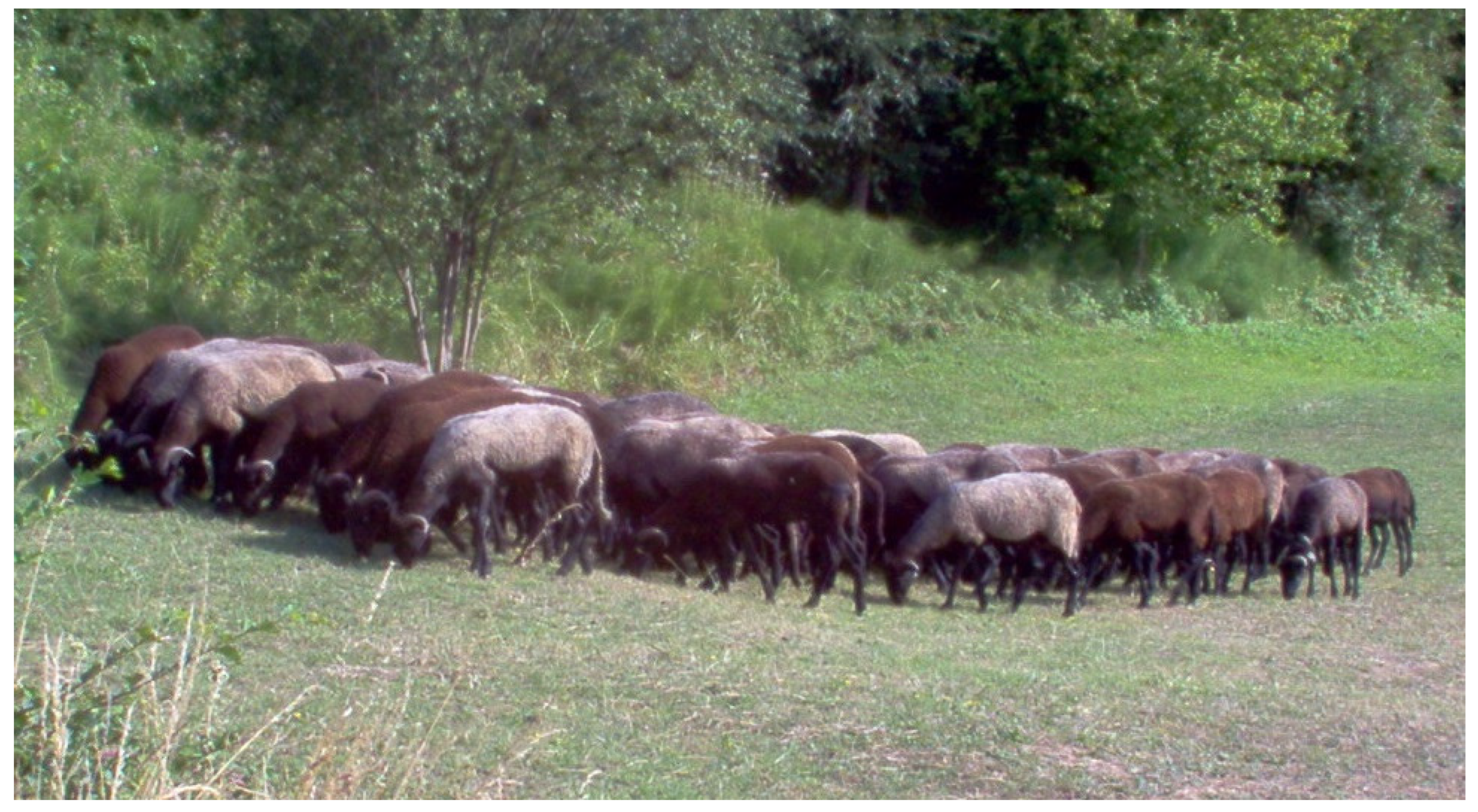
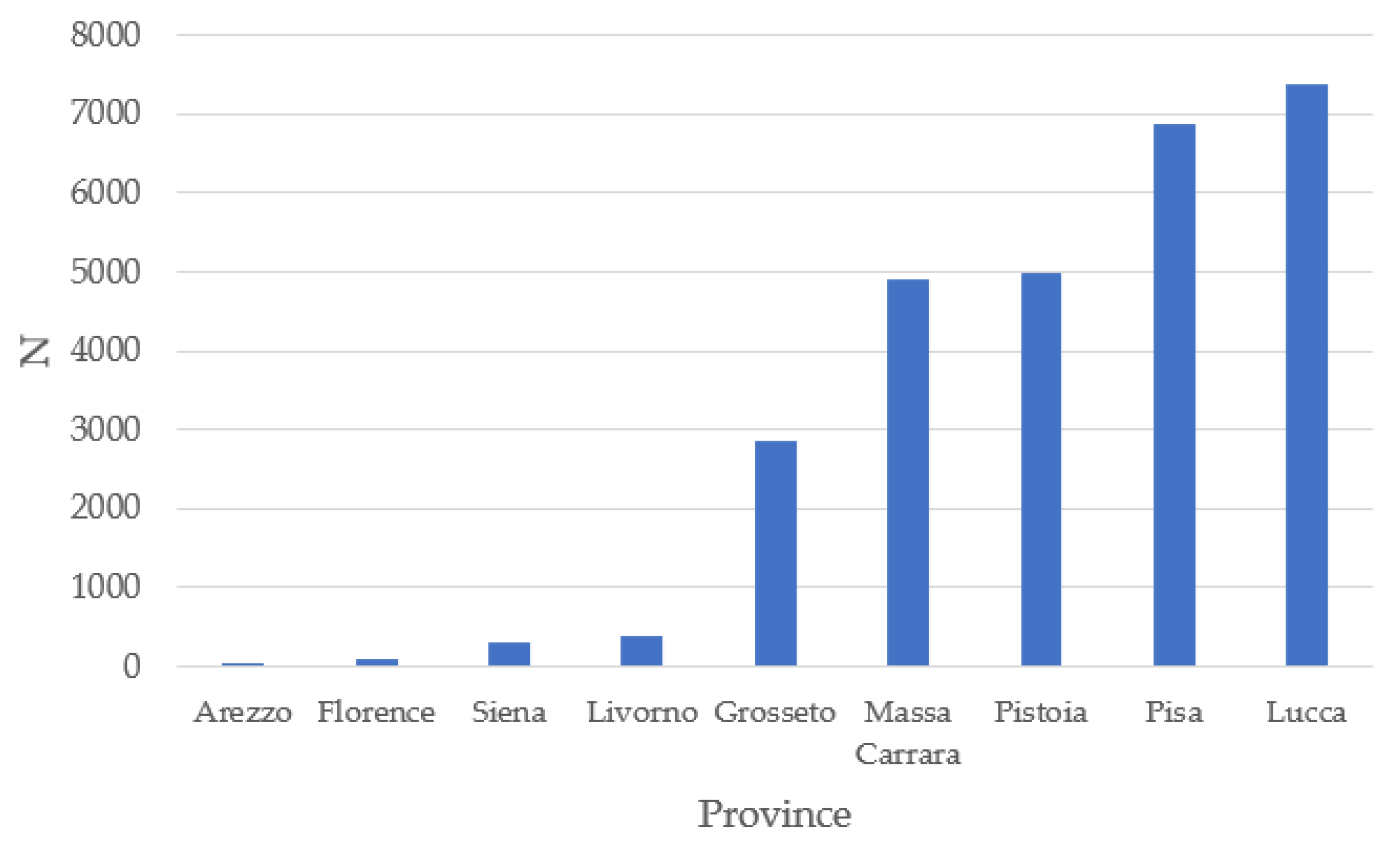
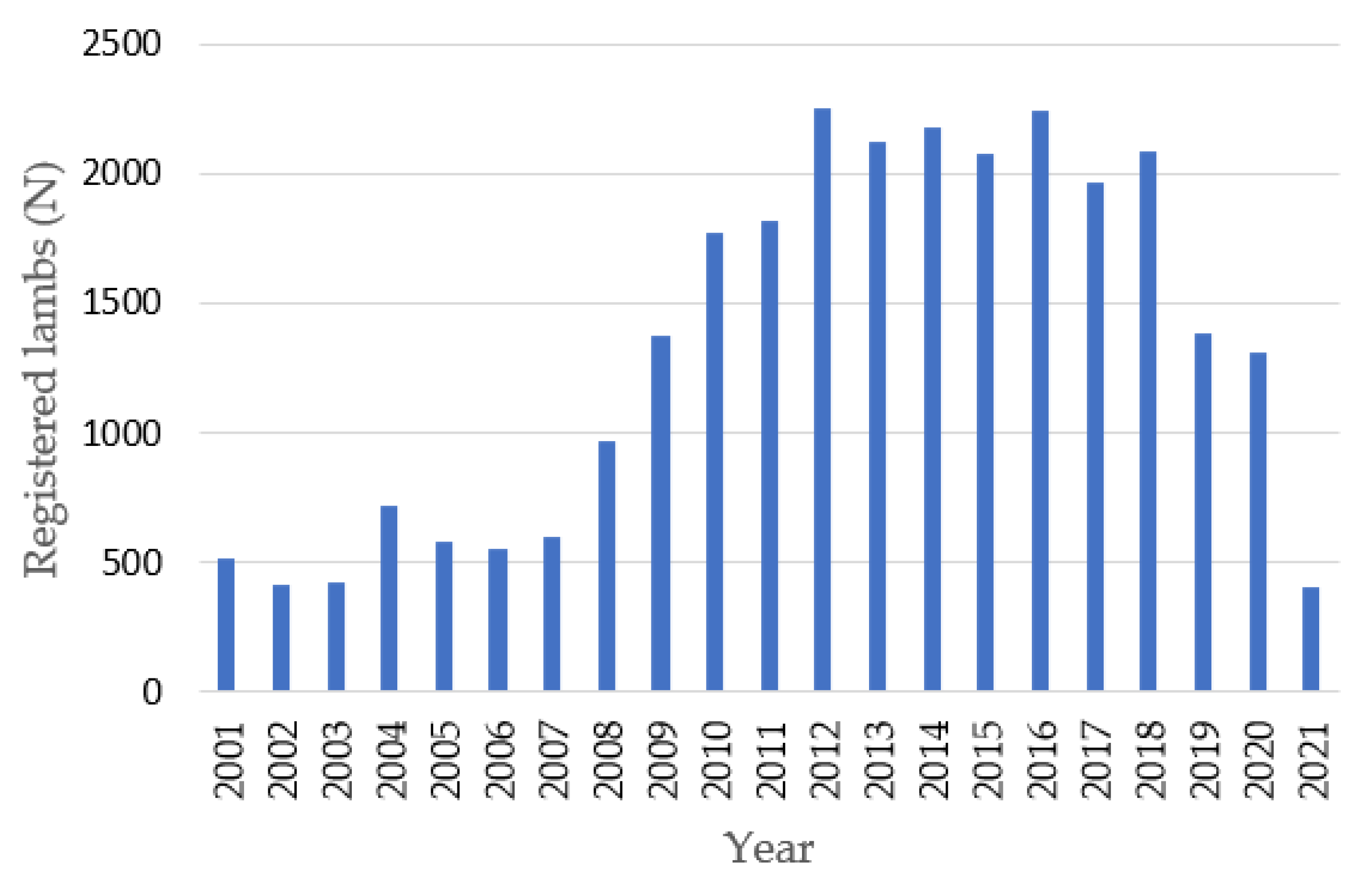
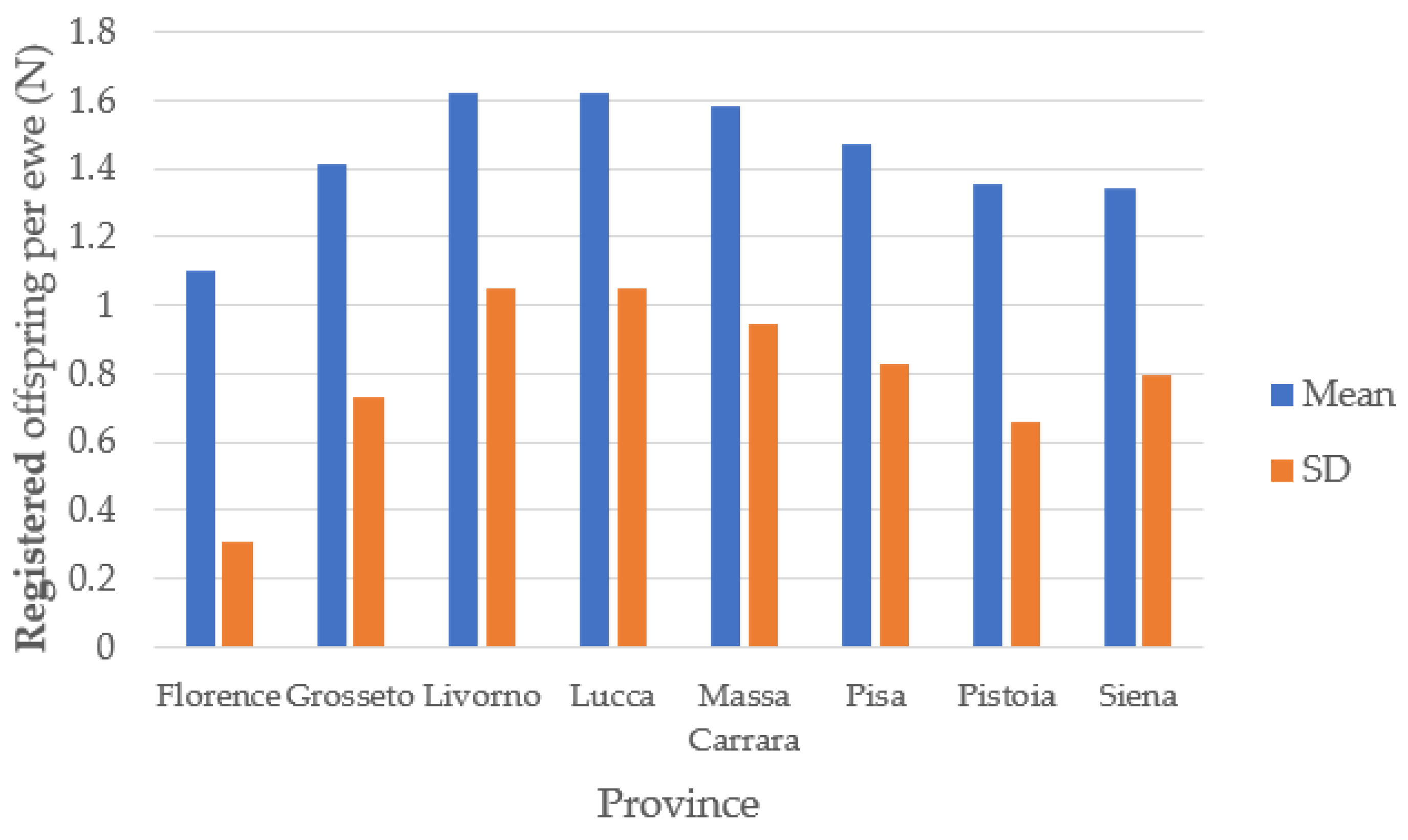
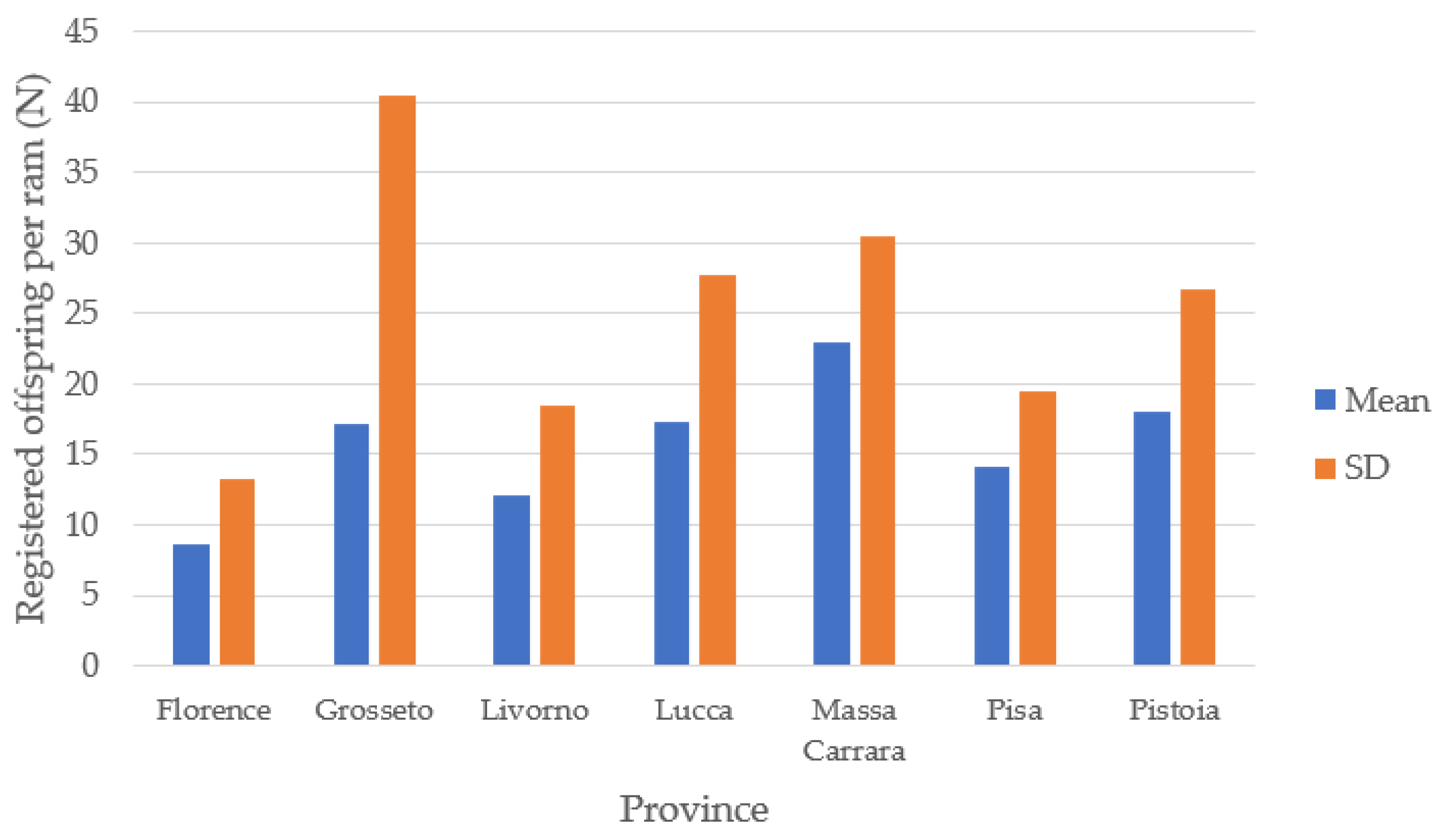
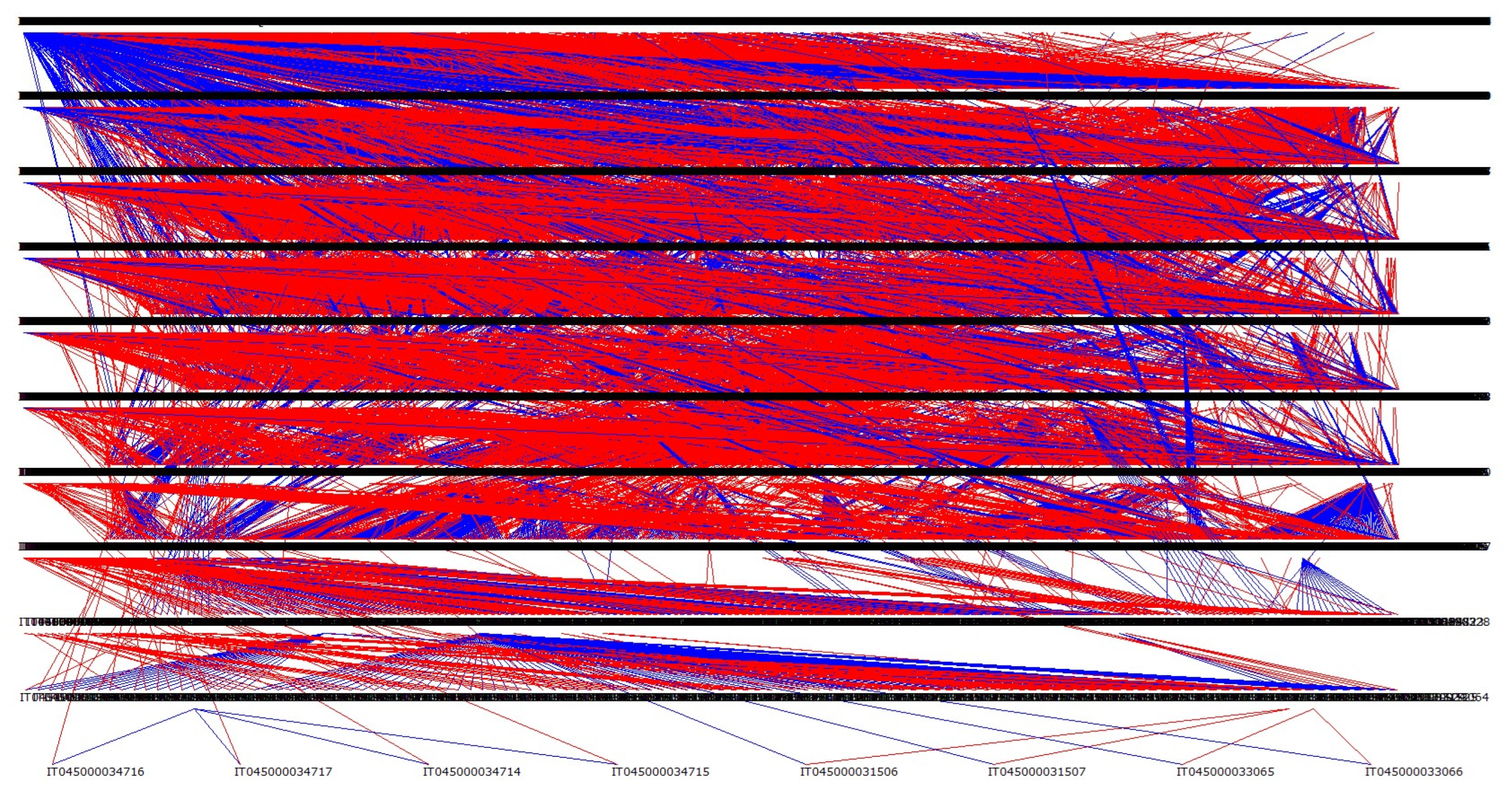
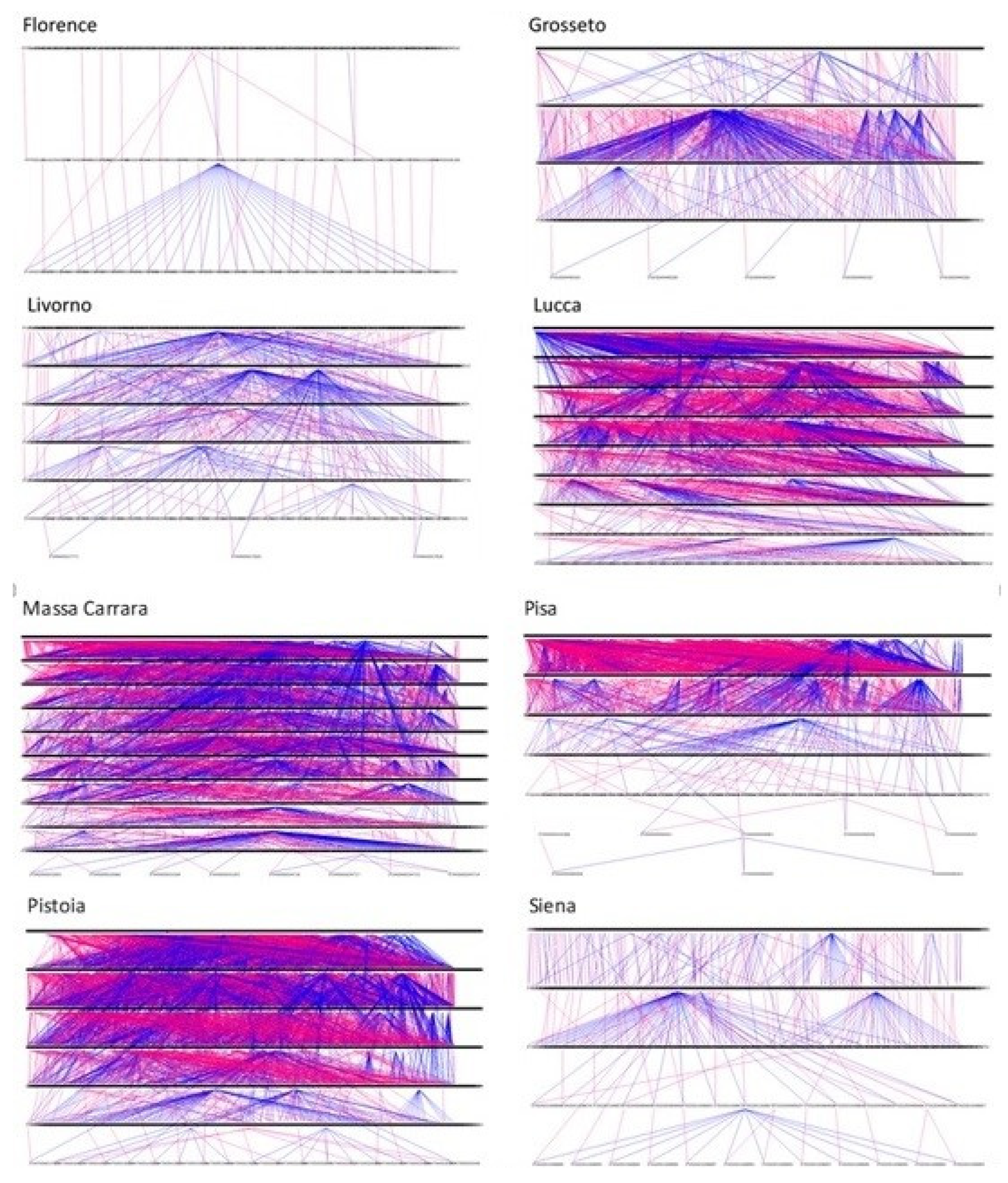
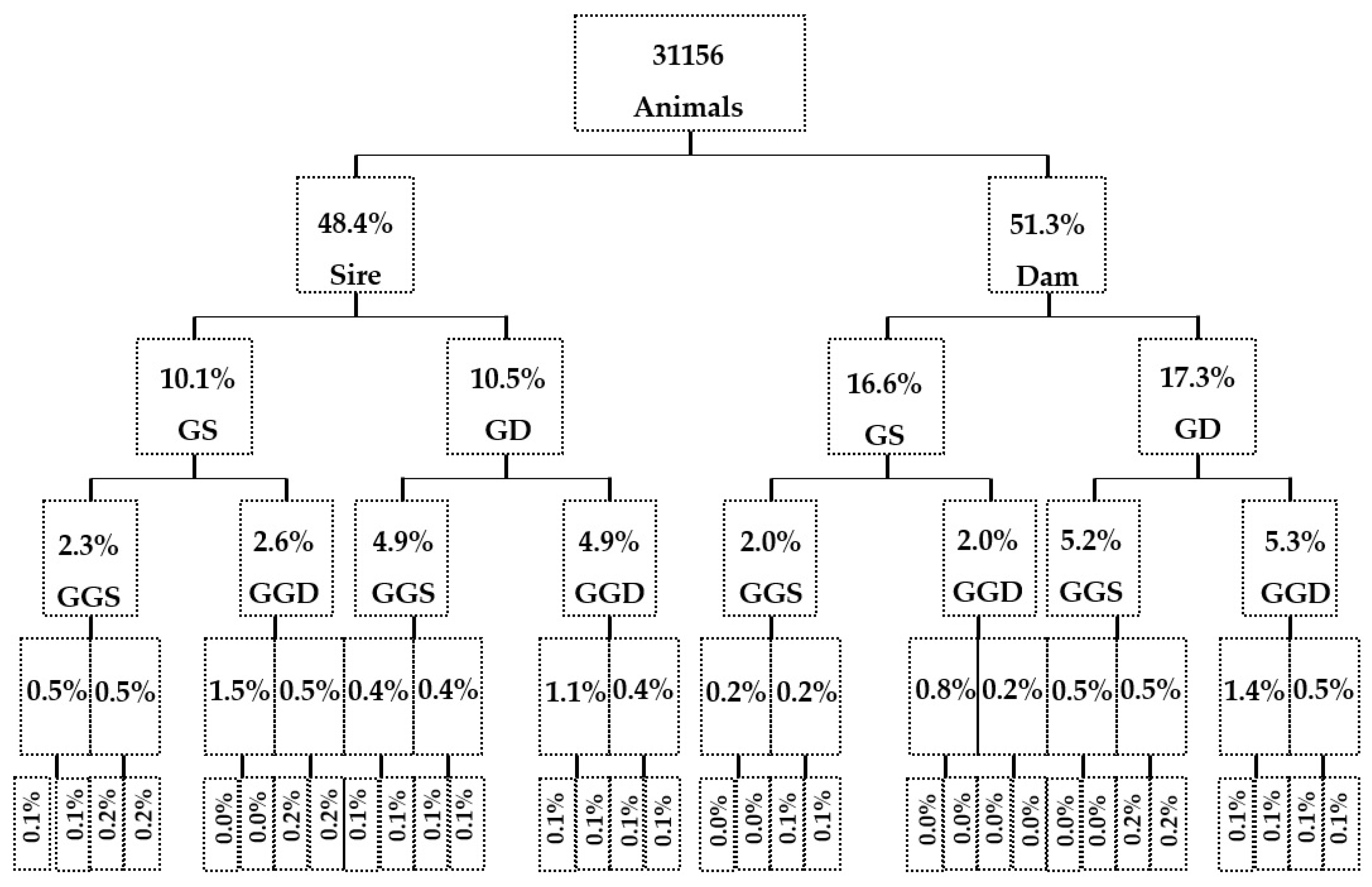
| Province | Longevity | |||||
|---|---|---|---|---|---|---|
| Rams | Ewes | |||||
| N | Mean | SD | N | Mean | SD | |
| Arezzo | 1 | 7.3 | - | |||
| Florence | 2 | 6.0 | 2.99 | 42 | 5.0 | 2.47 |
| Grosseto | 42 | 2.4 | 1.63 | 1093 | 7.1 | 3.27 |
| Livorno | 24 | 5.7 | 4.63 | 216 | 8.3 | 3.39 |
| Lucca | 54 | 13.1 | 5.36 | 3148 | 8.7 | 4.21 |
| Massa Carrara | 81 | 11.5 | 6.90 | 2082 | 10.7 | 5.28 |
| Pisa | 17 | 12.4 | 6.47 | 3954 | 8.4 | 3.73 |
| Pistoia | 114 | 5.0 | 4.39 | 2344 | 7.1 | 3.13 |
| Siena | 2 | 5.0 | 0.52 | 71 | 7.0 | 2.37 |
| WP (n): | 31,156 |
|---|---|
| Males | 1328 |
| Females | 29,828 |
| Sires | 660 |
| Dams | 12,662 |
| Number of individuals with both parents known | 12,602 |
| Inbreds | 2790 |
| Full-sib groups: | 1486 |
| -Average value | 2.15 |
| -Max | 6 |
| -Min | 2 |
| BP: | 18,554 |
| -Both parents unknown | 17,710 |
| -Only mother known | 784 |
| -Only father known | 60 |
| RP 2007–2021 | 24,586 |
| Number of individuals with both parents known | 10,803 |
| Inbreds | 2713 |
| Province | Herds (n) | Registered Animals (n) | Animals with Both Parents Known (n) | Average F (%) | ANR (%) | Inbred Animals (n) | Average F for Inbreds |
|---|---|---|---|---|---|---|---|
| Arezzo | 1 | 23 | 1 | 0.54 | 0.00 | 1 | 0.125 |
| Florence | 1 | 104 | 24 | 0.23 | 1.90 | 1 | 0.240 |
| Grosseto | 12 | 2847 | 527 | 0.19 | 0.20 | 29 | 0.188 |
| Livorno | 1 | 376 | 375 | 3.90 | 11.6 | 127 | 0.115 |
| Lucca | 32 | 7390 | 2793 | 1.60 | 0.40 | 797 | 0.144 |
| Massa Carrara | 21 | 4908 | 3722 | 3.10 | 1.50 | 1205 | 0.128 |
| Pisa | 26 | 6879 | 1267 | 0.05 | 0.06 | 17 | 0.192 |
| Pistoia | 14 | 4983 | 3698 | 1.70 | 0.50 | 614 | 0.138 |
| Siena | 3 | 297 | 195 | 0.30 | 1.60 | 15 | 0.052 |
| Range | RP | Province | ||||||||
|---|---|---|---|---|---|---|---|---|---|---|
| (n°) | Ar | Fi | Gr | Li | Lu | Ms | Pi | Pt | Si | |
| 0.00 < F < 0.05 | 447 | 5 | 29 | 108 | 198 | 2 | 98 | 7 | ||
| 0.05 < F < 0.10 | 632 | 36 | 160 | 312 | 1 | 115 | 8 | |||
| 0.10 < F < 0.15 | 720 | 1 | 6 | 36 | 178 | 295 | 6 | 202 | ||
| 0.15 < F < 0.20 | 319 | 8 | 106 | 156 | 49 | |||||
| 0.20 < F < 0.25 | 492 | 1 | 18 | 11 | 165 | 160 | 7 | 130 | ||
| 0.25 < F < 0.30 | 95 | 1 | 39 | 47 | 1 | 7 | ||||
| 0.30 < F < 0.35 | 48 | 5 | 14 | 20 | 9 | |||||
| 0.35 < F < 0.40 | 34 | 0 | 25 | 5 | 4 | |||||
| 0.40 < F < 0.45 | 3 | 1 | 2 | |||||||
Disclaimer/Publisher’s Note: The statements, opinions and data contained in all publications are solely those of the individual author(s) and contributor(s) and not of MDPI and/or the editor(s). MDPI and/or the editor(s) disclaim responsibility for any injury to people or property resulting from any ideas, methods, instructions or products referred to in the content. |
© 2024 by the authors. Licensee MDPI, Basel, Switzerland. This article is an open access article distributed under the terms and conditions of the Creative Commons Attribution (CC BY) license (https://creativecommons.org/licenses/by/4.0/).
Share and Cite
Giuliotti, L.; Benvenuti, M.N.; Preziuso, G.; Ventura, E.; Fresi, P.; Cecchi, F. Demography and Genealogical Analysis of Massese Sheep, a Native Breed of Tuscany. Animals 2024, 14, 582. https://doi.org/10.3390/ani14040582
Giuliotti L, Benvenuti MN, Preziuso G, Ventura E, Fresi P, Cecchi F. Demography and Genealogical Analysis of Massese Sheep, a Native Breed of Tuscany. Animals. 2024; 14(4):582. https://doi.org/10.3390/ani14040582
Chicago/Turabian StyleGiuliotti, Lorella, Maria Novella Benvenuti, Giovanna Preziuso, Emilia Ventura, Pancrazio Fresi, and Francesca Cecchi. 2024. "Demography and Genealogical Analysis of Massese Sheep, a Native Breed of Tuscany" Animals 14, no. 4: 582. https://doi.org/10.3390/ani14040582
APA StyleGiuliotti, L., Benvenuti, M. N., Preziuso, G., Ventura, E., Fresi, P., & Cecchi, F. (2024). Demography and Genealogical Analysis of Massese Sheep, a Native Breed of Tuscany. Animals, 14(4), 582. https://doi.org/10.3390/ani14040582





